#epidemic histories
Text

"SANATORIUM IS AGAIN DISCUSSED," Berlin (Kitchener) News Record. August 30, 1912. Page 1.
----
Ratepayers of West Ward Heard Addresses at King Edward School
----
A number of ratepayers, interested in the tuberculosis sanatorium by-law met in the King Edward school last evening where addresses were deliver ed on the subject.
Mr. Fred Zarnke was appointed chairman, and in an opening address, stated that he had come as a listener, not intending to take any part. It was the duty of every ratepayer he stated, to be present at the meetings in connection with various laws that came up from time DY to time, in order that they might cast a vote one way or the other. All the by-laws before the voters were important, although the tuberculosis sanatoriom was probably the most important.
Rev. F. E. Oberlander was the chief speaker, explaining why certain arrangements had been made. what the attitude of the government was in connection with this movement, and what it paid towards its construction and maintenance. In this the government was especially liberal and it was thought that when the sanatorium was completed, so far as the city was concerned, there the expense would stop.
It was plainly evidenced during lengthy discussion, that the General Hospital was certainly a place for the consumptive patient, since it would re-act with dire effects on the general efficiency of the hospital.
The various types of buildings as the laundry, heating plant, and stables, were discussed, with their probable cost. The seventeen acres would probably bring sufficient produce for the wants of those in the hospital. The caretaker, with his wife, would tend to the duties about the house and stable, and also care for the garden. They would be more than able to support themselves by their work.
The dread of the disease, tuberculosis, was very graphically illustrated, when in the course of his address, Mr. Oberlander stated that the majority of the people if given an opportunity to choose between small-pox, fevers or diphtheria and consumption, would not hesitate very long before choosing any other disease rather than the latter. The danger of infection is greater, and it has been shown in statistics that more people succumb to this than to any other disease. During his discussion, there were many interesting and intelligent questions asked, all of which the reverend gentleman cheerfully and satisfactorily answered.
An excellent address was listened to from Dr. Callahan who, as a medical man, came in contact with the disease frequently. He was unhesitatingly in favor of the by-law voting $15,000 for the sanatorium, where all cases no matter how far advanced, could be cared for. To indicate the chances for a cure to be effected by the fresh air treatment, he cited the case of a college friend, who by residing in Muskoka for several years was practically cured. Therefore, knowing the good of the cure, he was anxious that all those afflicted in Berlin should have the opportunity.
Dr. Huehnergaro was called upon to speak, and delivered a very good address. He stated that he was pleased that the government was taking an interest in the question. In former years, they expended thous- ands of dollars to trace and stamp out a disease that affected cattle or horses, and had now gone ward one step, taking the same interest in the people of the country as in the cattle realizing the value of human life.
The Board of Health was required to report to the Provincial Board which made inquiries into each case in order to ascertain that the Health acts were being complied with.
The meeting all through was interspersed with questions that made it interesting and helpful.
#kitchener#public meeting#ratepayers#taxpayers as pressure groups#tuberculosis#tuberculosis sanatorium#sanatorium#history of canadian healthcare#history of healthcare#epidemic histories
2 notes
·
View notes
Text




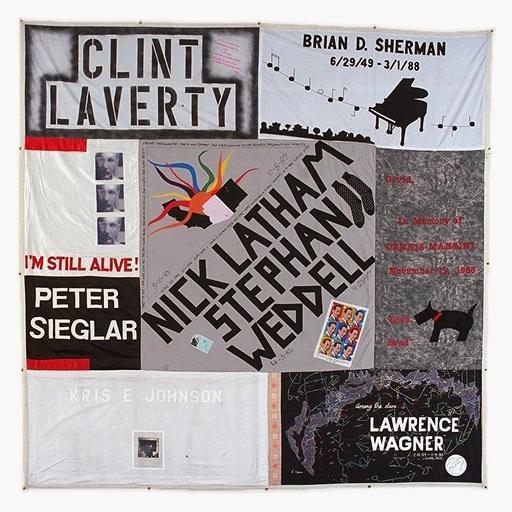




"let love replace fear through you."
AIDS QUILT SERIES | VIEW THE QUILT
#*aq#aids quilt#aids activism#hiv aids#act up fight aids#fight aids#aids#hiv/aids#aids epidemic#lgbtq#lgbtq history#lgbt history#queer history#i see that some folks have found my quilt tag & are reblogging.#& it inspired me to make another post before pride month is out.#thank you to everyone who reblogs one of these posts. i mean that.#thank you for taking a moment to love those who were taken.#anyway it was so hard to choose a tagline for this particular one...#' the face of the world has been changed forever. '#' our hearts will always be together. '#' i'm still alive! '#' for all the women. '#' for david who loved the minnesota prairie. '#' for everyone... love amy. '#& i feel you amy.#for everyone indeed.
424 notes
·
View notes
Text
"The “Düsseldorf Patient”, a man now aged 53, is just the third person worldwide to have been completely cured of HIV via stem cell transplantation.
As in the case of the other two patients, the so-called “Berlin Patient” and “London Patient,” the transplantation was undertaken to treat an acute blood disease, which had developed in addition to the HIV infection.
The Düsseldorf Patient received a stem cell transplant used to treat leukemia in 2013 and has shown persistent suppression of HIV-1 ever since, including during the last 4 years after the patient stopped taking anti-retroviral medication.
“I still remember very well the sentence from my family doctor: ‘don’t take it so hard,'” the Düsseldorf Patient, who had leukemia as well as HIV-1, said in a statement. “‘We will experience together that HIV can be cured!’ At the time, I dismissed the statement.”
Allogeneic hematopoietic stem cell transplantation (HSCT) is a procedure used to treat certain cancers, such as leukemia, by transferring immature blood cells from a donor to repopulate the bone marrow of the recipient.
Scientists now understand that individuals with two copies of the Δ32 mutation in the gene for the HIV-1 co-receptor CCR5; are resistant to HIV-1 infection. The two previous cases of both the London patient and the Berlin patient involved receiving a stem cell transplant from a donor with these unique mutations.
Björn-Erik Jensen, a specialist in infectious diseases at Düsseldorf University Hospital, lead the treatment and subsequent research, revealed today in a peer-reviewed study in Nature.
The patient was diagnosed as having acute myeloid leukemia and proceeded to undergo transplantation of stem cells from a female donor in 2013, followed by chemotherapy and infusions of donor lymphocytes.
After the transplantation, anti-retroviral therapy was continued, but HIV was undetectable in the patient’s blood cells. Anti-retroviral therapy was suspended in November 2018 with the patient’s informed consent, almost 6 years after the stem cell transplantation, to determine whether the virus persisted in the patient.
“I very much hope that these doctors will now get even more attention for their work,” said the patient. “I have now decided to give up some of my private life to support research fundraising. And of course, it will also stay very important for me to fight the stigmatization of HIV with my story.”
The authors conclude that although HSCT remains a high-risk procedure that is at present an option only for some people living with both HIV-1 and hematological cancers, these results may inform future strategies for achieving long-term remission of HIV-1."
-via Good News Network, 2/20/23
VERIFIED 10 YEARS ON, PROOF THAT HIV IS CURABLE
#hiv#health care#hiv aids#aids epidemic#aids crisis#lgbtq#lgbtq history#queer#queer history#hiv treatment#sex ed#medical news#medical research#good news#hope#I know he's not the first person we found cured of hiv#but as they say#three is a pattern#ANY increase in sample size at this stage is absolutely historical
398 notes
·
View notes
Text
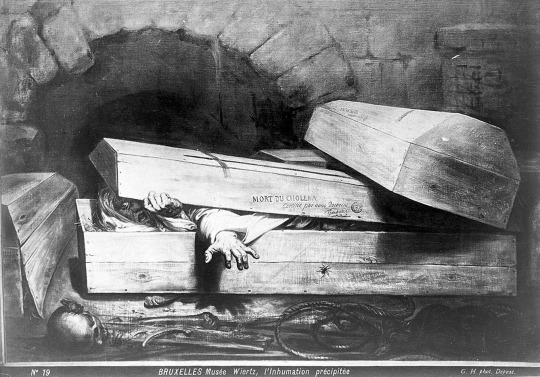
A man with cholera buried prematurely. Photograph after painting by A. J. Wiertz.
Wiertz, Anton Joseph, 1806-1865
Wellcome Collection
#biology#history#own post#curiosity#anatomy#medical#medicine#art#human anatomy#art history#cholera#macabre#macabre art#death#burial#coffin#epidemics#anatomical illustration
138 notes
·
View notes
Photo
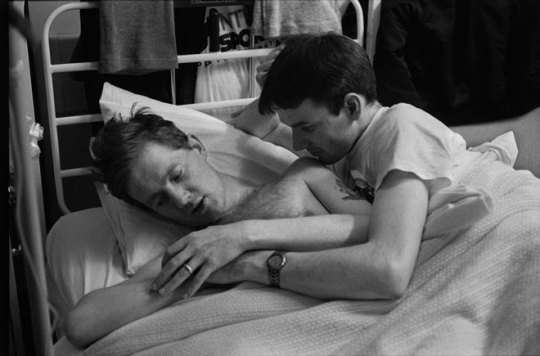


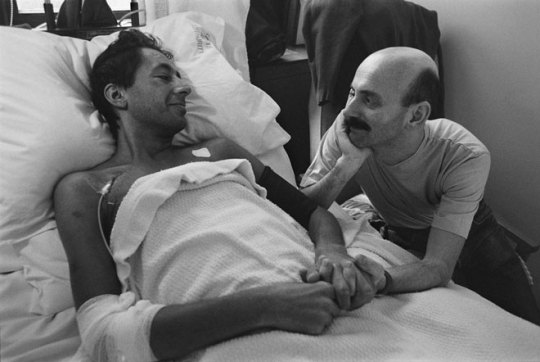
AIDS patients with their loved ones, 1993 (Gideon Mendel, The Ward)
#aids#hiv#lgbt history#queer history#gay history#gideon mendel#photography#black and white#b&w photography#aids epidemic#intimacy
177 notes
·
View notes
Text
Daily reminder that Mother Teresa was a shitty person who said that AIDS was god’s punishment to gay people for being gay and that pain brought people closer to god so she didn’t upgrade the awful conditions of her clinics.
She died with $100 million in multiple bank accounts.
Her clinics had to REUSE NEEDLES DURING THE AIDS EPIDEMIC BECAUSE OF HER. She was a glorified serial killer.
She had nuns secretly “baptize” Hindus and Muslims as they were dying while pretending to pat their heads with wet rags.
She got top notch medical care when she needed it, but again, her patients weren’t being cared for properly and she told them to their faces that they had to suffer like Jesus. She didn’t have to suffer, though. Paraphrasing this conversation between her and a dying patient:
MT: your suffering is because Jesus is kissing you.
Man suffering: can you ask him to stop kissing me?
MT: 🥰🥰🥰🥰
(she didn’t get that he was angry for what she was saying)
Not sure why she was considered a Saint but I suppose you can buy a sainthood.
#mother teresa#eject me into the sun#politics#mine#anti religion#anti catholic#anti christianity#aids epidemic#history#shitty people of history#rant#lgbt
168 notes
·
View notes
Text
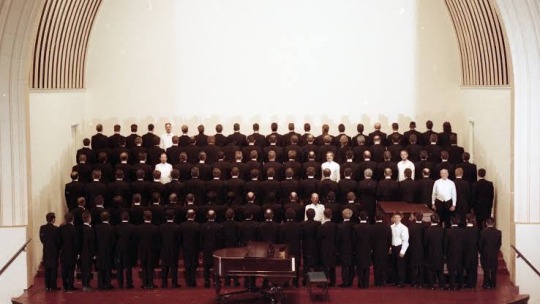
San Francisco Gay Men's Chorus demonstrating impact of AIDS on the choir, white shirts representing members still alive (1993)
#queer#gay#queer history#aids#aids epidemic#San Francisco Gay Mens Chorus#gay men#lgbt history#post#gay history
464 notes
·
View notes
Text

Instructing nurses on use of an iron lung for a polio patient, 5/23/1958. Online here.
POLIO STRIKES BACK
By Miriam Kleiman, Public Affairs

Child at "French clinic for polio victims" , Marshall Plan records, NARA ID 19992258.
Like COVID, polio is an infectious disease that once terrorized people worldwide and led to quarantines, shutdowns, illness and death. Some polio patients relied on not ventilators to breathe but an “iron lung” - a large pressurized cylinder wherein victims would lie and oxygen would be drawn into the person’s lungs by creating a vacuum.
Polio timeline:
1894-1st documented US Polio epidemic
1921 - FDR contracts polio at age 39 (see FDR and Polio)
1954- Salk polio vaccine trials begin for 1.8 million children.
1955 - Scientists deem polio vaccine safe and effective.
1979 - Polio considered "eliminated" from the US thanks to widespread polio vaccination.
But IT'S BACK.
2022 - CDC announces (9/13/22) polio cases in New York.

Patient in an iron lung, USAF # A52930AC, NARA ID 204964233.

Student Robert Henninger gets the polio vaccine in 1954. Photo by Getty Images.

President Eisenhower’s support for the vaccine drive (NARA ID 12166372).
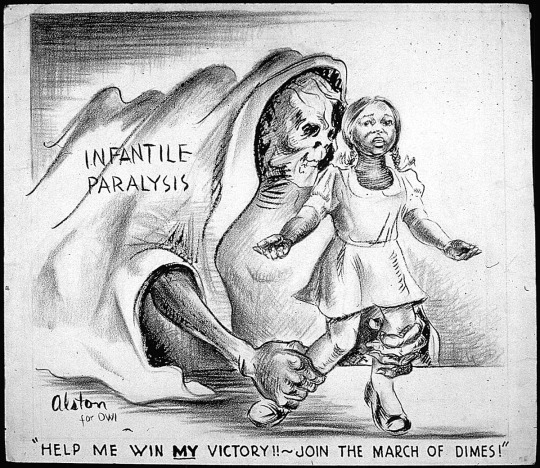
WW2 drawing by Charles Henry Alston for the Office of War Information. NARA ID 535617.
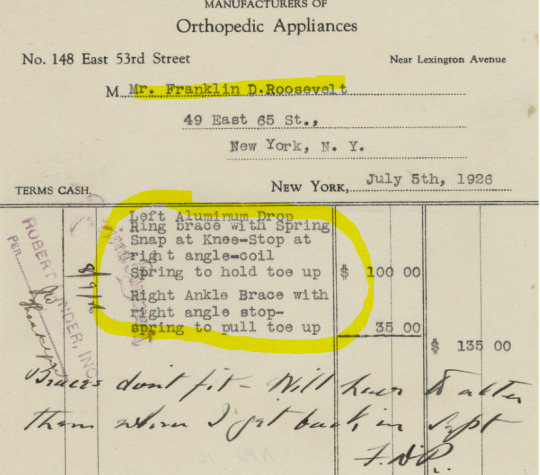
Prescription for FDR's leg braces that includes his note that the braces don’t fit, 7/5/1926. FDR Family records, FDR Library.
One president was directly affected by polio - FDR, who contracted polio while on vacation in 1921 at age 39 and became paralyzed from the waist down. While he hid this condition from the public, for the rest of his life he tried to find a way to rehabilitate himself and others afflicted with infantile paralysis. He established the March of Dimes on January 3, 1938, with the original name "National Foundation of Infantile Paralysis."
More online:
FDR and Polio, FDR Library
POLIO Vaccine Trials began #OTD 1954
Letter from FDR to Dr. Egleston Regarding his Polio Attack
WORLD IMMUNIZATION WEEK
FLASHBACK: How NOT to Promote Vaccines
The Man He Became: How FDR Defied Polio to Win the Presidency, FDR Library program with James Tobin
Today's Document May 23rd
#polio#pandemic#epidemic#vaccine#science#medical history#vaccination#gotmyshot#vaccineswork#sleeveup#fdr#fdrlibrary#roosevelt#franklin delano roosevelt
306 notes
·
View notes
Text

#hiv/aids#hivpositive#health care#discrimination#sex ed#aids#hiv aids#hiv stigma#aids activism#disability aids#sleep aids#band aids#aids crisis#lgbtq history#aidsawareness#aids epidemic#aids quilt#republicans#christianity#religion#catholicism#theology#religious#catholic
101 notes
·
View notes
Text
I just finished reading Destination Unknown by Bill Konigsberg. Its about a teenage gay couple during the AIDS epidemic and the community they find and its heartbreaking. Its beautiful how you see this young queer guy experience queer people living and being openly and happily queer for the first time but at the same time theres this constant fight going on in the background because people are dying and nobody cares. It was a really emotional book but the thing that hit me the most was reading the authors notes at the end of the book and finding out that these were his experiences. He was that queer teenager growing up in that culture of freedom and fear. He went to the AIDS walks. He witnessed the ACT UP protests. He spoke to Marsha P. Johnson and Larry Kramer as a teenager. He delivered meals to people living with AIDS every week. Its so real and so raw and it made me want to scream. Even if you dont wanna read the book this is a reminder to read up on your queer history. We arent new, weve always been here.
25 notes
·
View notes
Text

"FORTY FIVE ARE AIDED EVERY WEEK," Ottawa Journal. January 24, 1913. Page 1.
----
Union Mission Still Finds Much to do.
----
Despite Mild Weather and "Easy" Winter.
----
Local Charitable Organizations Report That Considerable Distress is Evident, Some due to Typhoid Epidemic.
----
Although we have had a mild winter up to the present there seems to be the usual number of men idle in the city.
One or two business men said that they cannot get men while there have been several applications for work made to the Associated Charities and other organizations.
Extra cases of distress have occurred apparently, as the result of the typhoid fever outbreak in the summer. Staff Adj. Goodwin of the Salvation Army informed The Journal last night that the outbreak of fever last summer had caused a great many cases of distress, cases that had never been known before and fresh cases are still occurring.
The Union Missions for men has not been so heavily taxed up to the present this winter, this being due to the mild weather. On an average 45 men are assisted each week and at present 30 men are being sheltered each night besides being provided with meals if the cases are real necessitous ones. For those who are able to pay, a small charge is made for bed and meals. Endeavors are made to find employment for the men but there have not been quite so many applications in previous years. Owing to the mildness of the weather several men have been able to leave the city for work.
#ottawa#typhus#epidemic histories#unemployment#unemployed#homeless shelters#christian charity#missions#salvation army#charitable philanthropy#welfare as social control#poverty in canada
1 note
·
View note
Text
astarion goes from being a metaphorical vampire as a corrupt magistrate to being a literal one and it has me shook™️
#reading a fascinating book about the history of the modern vampire#and it has brought up some incredible points and facts#’stories of vampire epidemics should be taken as attempts to subtly criticize the local elite and law making bodies’#me giggling and kicking my legs like a school girl#my ramblings#vampirism#bg3#bg3 astarion#astarion
25 notes
·
View notes
Text
Is anybody well versed on the AIDs epidemic? I'm writing a story and it takes place during it and I wanted someone to fact check and to give some info on it.
#aids#aids epidemic#queer community#queer#queer history#gay history#lgbtq#lgbtqia#lgbtq history#writeblr#writers on tumblr#my writing#writing#advice
8 notes
·
View notes
Text
I Promise to Live
a poem about the queer experience and activism
When you’re queer, life is a conscious decision.
Every morning I wake up and tell myself,
“Today I will be alive”
“Today I will be myself”
“Today I won’t let them win”
I wake up every day ready to fight,
To fight for Marsha P Johnson
To fight for Matthew Shepard
To fight for Sylvia Rivera
For Freddie Mercury
For Harvey Milk
For Walt Whitman
Harry Allen
Audre Lorde
Everyone who lost their lives to a virus doctors refused to treat.
Today, I fight for me,
I will fight for the future so no one has to feel this pain ever again,
I promise to Never let my flame die and to carry the flame of those who burnt the cop cars
So I could be here today,
So I could choose to Breathe,
So I could Promise to Live
#gay#lesbian#bisexual#transgender#lgbtqiia+#original poem#writing#activism#queer#queer history#marsha p johnson#harvey milk#sylvia rivera#matthew shepard#freddie mercury#aids epidemic#pride month#love#self love#internalized homophobia#fighting
29 notes
·
View notes
Text
To all the people out there who mock queer ships and headcannons for stranger things and say "it can't be gay, its set in the 80s" or "gay people didn't exist in the 80s" i just need you all to know the following:
The 80s were gay, the 80s were SO gay. You think that the campiest decade of all time was straight??? You are simply wrong. The 80s were so gay that the US government weaponized incompetence in healthcare specifically to target the queer community, and gay men especially. The 80s were so gay that they decided to name a disease GRID (Gay-Related Immune Deficiency) for two whole years as a scare tactic. The 80s were SO gay that Reagan actively decided to default on payments to the WHO during a period of time when they were doing research into what people (in the 80s!!!!) were calling 'the gay plague' or 'gay cancer' because as far as the Reagan administration was concerned HIV/AIDS was a joke. The 80s were so gay that the lgbt community is still recovering from the damages and loss that came from not only HIV/AIDS, but from the homophobic backlash brought about by the purposeful and wilful spread of misinformation regarding it. The 80s were so gay that by 1988 AIDS was the third leading cause of death for men between the ages of 25-44 years of age, and 59% of those deaths were happening among gay or bisexual men (because the government chose not to act for basically seven straight years). Between 1981 and 1990 over 100,000 people died Because the government didn't want to help the MANY gay people that were being affected.
Like I don't give a f#ck if you don't like a gay ship or headcannon but I do give a f#ck about you erasing queer history and trauma as a way to argue with people about things in some fandom. The AIDS crisis hurt us, and the 80s were f#cking gay.
#Stranger Things#steddie#byler#ronance#lgbt+#lgbt history#the 80s#hiv/aids#aids epidemic#aids crisis#aids history#you want to be homophobic sure whatever but i refuse to listen to one more person act like the aids crisis didnt happen
169 notes
·
View notes
Text
It is August 1854, and London is a city of scavengers. Just the names alone read now like some kind of exotic zoological catalogue: bone-pickers, rag-gatherers, pure-finders, dredgermen, mud-larks, sewer-hunters, dustmen, night-soil men, bunters, toshers, shoremen. These were the London underclasses, at least a hundred thousand strong. So immense were their numbers that had the scavengers broken off and formed their own city, it would have been the fifth-largest in all of England. But the diversity and precision of their routines were more remarkable than their sheer number. Early risers strolling along the Thames would see the toshers wading through the muck of low tide, dressed almost comically in flowing velveteen coats, their oversized pockets filled with stray bits of copper recovered from the water's edge. The toshers walked with a lantern strapped to their chest to help them see in the predawn gloom, and carried an eight-foot-long pole that they used to test the ground in front of them, and to pull themselves out when they stumbled into a quagmire. The pole and the eerie glow of the lantern through the robes gave them the look of ragged wizards, scouring the foul river's edge for magic coins. Beside them fluttered the mud-larks, often children, dressed in tatters and content to scavenge all the waste that the toshers rejected as below their standards: lumps of coal, old wood, scraps of rope.
Above the river, in the streets of the city, the pure-finders eked out a living by collecting dog shit (colloquially called “pure”) while the bone-pickers foraged for carcasses of any stripe. Below ground, in the cramped but growing network of tunnels beneath London's streets, the sewer-hunters slogged through the flowing waste of the metropolis. Every few months, an unusually dense pocket of methane gas would be ignited by one of their kerosene lamps and the hapless soul would be incinerated twenty feet below ground, in a river of raw sewage.
The scavengers, in other words, lived in a world of excrement and death. Dickens began his last great novel, Our Mutual Friend, with a father-daughter team of toshers stumbling across a corpse floating in the Thames, whose coins they solemnly pocket. “What world does a dead man belong to?” the father asks rhetorically, when chided by a fellow tosher for stealing from a corpse. “'Tother world. What world does money belong to? This world.” Dickens' unspoken point is that the two worlds, the dead and the living, have begun to coexist in these marginal spaces. The bustling commerce of the great city has conjured up its opposite, a ghost class that somehow mimics the status markers and value calculations of the material world. Consider the haunting precision of the bone-pickers' daily routine, as captured in Henry Mayhew's pioneering 1844 work, London Labour and the London Poor:
It usually takes the bone-picker from seven to nine hours to go over his rounds, during which time he travels from 20 to 30 miles with a quarter to a half hundredweight on his back. In the summer he usually reaches home about eleven of the day, and in the winter about one or two. On his return home he proceeds to sort the contents of his bag. He separates the rags from the bones, and these again from the old metal (if he be luckly enough to have found any). He divides the rags into various lots, according as they are white or coloured; and if he have picked up any pieces of canvas or sacking, he makes these also into a separate parcel. When he has finished the sorting he takes his several lots to the ragshop or the marine-store dealers, and realizes upon them whatever they may be worth. For the white rags he gets from 2d. to 3d. per pound, according as they are clean or soiled. The white rags are very difficult to be found; they are mostly very dirty, and are therefore sold with the coloured ones at the rate of about 5 lbs. for 2d.
The homeless continue to haunt today's postindustrial cities, but they rarely display the professional clarity of the bone-picker's impromptu trade, for two primary reasons. First, minimum wages and government assistance are now substantial enough that it no longer makes economic sense to eke out a living as a scavenger. (Where wages remain depressed, scavenging remains a vital occupation; witness the perpendadores of Mexico City). The bone collector's trade has also declined because most modern cities possess elaborate systems for managing the waste generated by their inhabitants. (In fact, the closest American equivalent to the Victorian scavengers – the aluminium-can collectors you sometimes see hovering outside supermarkets – rely on precisely those waste-management systems for their paycheck.) But London in 1854 was a Victorian metropolis trying to make do with an Elizabethan public infrastructure. The city was vast even by today's standards, with two and a half million people crammed inside a thirty-mile circumference. But most of the techniques for managing that kind of population density that we now take for granted – recycling centers, public-health departments, safe sewage removal – hadn't been invented yet.
And so the city itself improvised a response – an unplanned, organic response, to be sure, but at the same time a response that was precisely contoured to the community's waste-removal needs. As the garbage and excrement grew, an underground market for refuse developed, with hooks into established trades. Specialists emerged, each dutifully carting goods to the appropriate site in the official market: the bone collectors selling their goods to the bone-boilers, the pure-finders selling their dog shit to tanners, who used the “pure” to rid their leather goods of the lime they had soaked in for weeks to remove animal hair. (A process widely considered to be, as one tanner put it, “the most disagreeable in the whole range of manufacture.”)
We're naturally inclined to consider these scavengers tragic figures, and to fulminate against a system that allowed so many thousands to eke out a living by foraging through human waste. In many ways, this is the correct response. (It was, to be sure, the response of the great crusaders of the age, among them Dickens and Mayhew.) But such social outrage should be accompanied by a measure of wonder and respect: without any central planner coordinating their actions, without any education at all, this itinerant underclass managed to conjure up an entire system for processing and sorting the waste generated by two million people. The great contribution usually ascribed to Mayhew's London Labour is simply his willingness to see and record the details of these impoverished lives. But just as valuable was the insight that came out of that bookkeeping, once he had run the numbers: far from being unproductive vagabonds, Mayhew discovered, these people were actually performing an essential function for their community. “The removal of the refuse of a large town,” he wrote, “is, perhaps, one of the most important of social operations.” And the scavengers of Victorian London weren't just getting rid of that refuse – they were recycling it.
— The Ghost Map: The Story of London's Most Terrifying Epidemic - and How it Changed Science, Cities and the Modern World (Steven Johnson)
#book quotes#steven johnson#the ghost map#the ghost map: the story of london's most terrifying epidemic - and how it changed science cities and the modern world#history#sanitation#waste management#recycling#economics#poverty#employment#labour#sociology#homelessness#welfare#authors#britain#victorian britain#england#london#thames#mudlarks#toshers#tanners#charles dickens#henry mayhew
49 notes
·
View notes